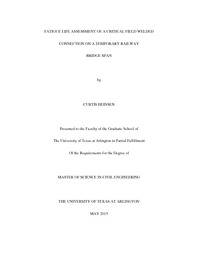
ATTENTION: The works hosted here are being migrated to a new repository that will consolidate resources, improve discoverability, and better show UTA's research impact on the global community. We will update authors as the migration progresses. Please see MavMatrix for more information.
Show simple item record
| dc.contributor.author | Heinsen, Curtis | en_US |
| dc.date.accessioned | 2015-07-31T22:10:03Z | |
| dc.date.available | 2015-07-31T22:10:03Z | |
| dc.date.submitted | January 2015 | en_US |
| dc.identifier.other | DISS-13046 | en_US |
| dc.identifier.uri | http://hdl.handle.net/10106/25020 | |
| dc.description.abstract | There is a need in the railway industry for a flexible solution to the problem of service interruptions due to impacts on railway bridges from highway and other vehicle traffic. One such solution is the placement of a temporary span that can be used on multiple substructure types and configurations and can be quickly assembled from a kit of available parts. In order to minimize the erection time and maximize the span flexibility such a span could utilize welded connections in place of bolted connections throughout the structure. These connections would be vulnerable to fatigue failure which has been shown in the AREMA design manual as well as various literature to be the primary limiting factor on the effective lifespan of most steel railway structures including the temporary span. This thesis analyzes such a structure using the finite element method and attempts to determine the controlling fatigue life for any number of reasonable configurations in which the span is likely to be utilized. Then a determination is made as to whether the design is valid for use in an emergency situation where a replacement structure could take months or even years to design, fabricate and construct. Phase 1 of this study leverages the finite element analysis capability of RISA 3D to determine the location of the most fatigue vulnerable connection in all of the considered configurations of the temporary span. Multiple load cases are considered including the controlling "315K" railcar. From this analysis an acceptable approximation of the real life forces the connection is subjected to can be obtained as well as a good idea of the applied forces and cycle frequency experienced by the connection. Phase 2 of this study utilizes the finite element method (FEM) functionality of ABAQUS to obtain parameters necessary for the completion of a comprehensive fatigue analysis. Parameters that were obtained during the analysis include the effective stress range (ÄSre) at the toe of the fillet weld in the critical connection, the stress intensity factors for a crack at the toe of the weld (KI, KII, KIII), and the residual stresses induced by an arc welding procedure (óres). Phase 3 of this study utilizes the principles of linear elastic fracture mechanics to propose a procedure for the estimation of the fatigue life of the critical connection in terms of number of cycles to failure both considering and neglecting residual stress effects. Finally, the significance of this research relative to the usefulness of the temporary span is discussed and recommendations regarding how to leverage the results of this research for real world use cases of the temporary span are put forward. | en_US |
| dc.description.sponsorship | Razavi, Mohammad | en_US |
| dc.language.iso | en | en_US |
| dc.publisher | Civil & Environmental Engineering | en_US |
| dc.title | Fatigue Life Assessment Of A Critical Field Welded Connection On A Temporary Railway Bridge Span | en_US |
| dc.type | M.S. | en_US |
| dc.contributor.committeeChair | Razavi, Mohammad | en_US |
| dc.degree.department | Civil & Environmental Engineering | en_US |
| dc.degree.discipline | Civil & Environmental Engineering | en_US |
| dc.degree.grantor | University of Texas at Arlington | en_US |
| dc.degree.level | masters | en_US |
| dc.degree.name | M.S. | en_US |
Files in this item
- Name:
- Heinsen_uta_2502M_13046.pdf
- Size:
- 4.370Mb
- Format:
- PDF
This item appears in the following Collection(s)
Show simple item record


